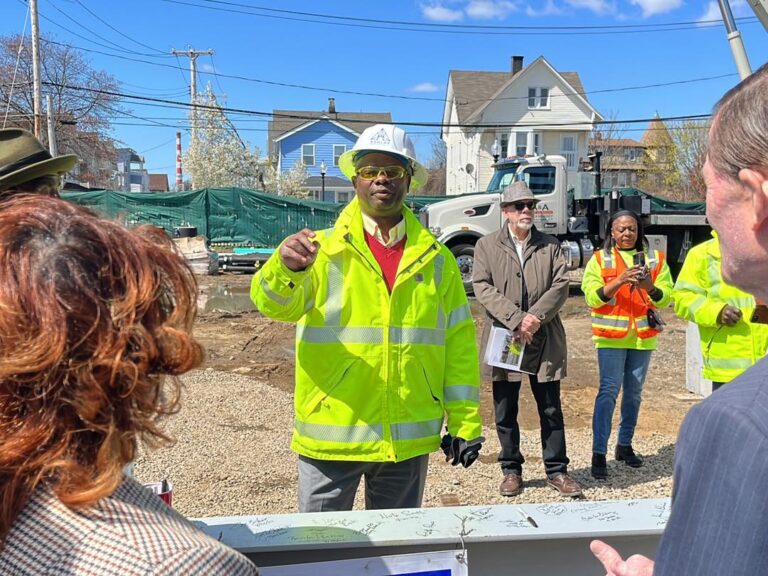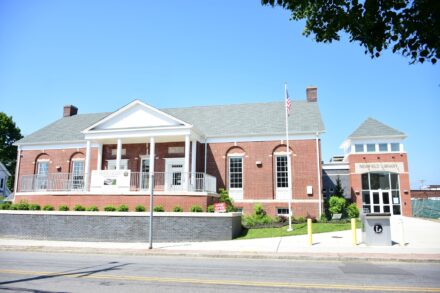
A vital development in the East End that includes a grocery store, healthcare facility, pharmacy and jazz-themed restaurant was approved for a total $1 million infusion by the City Council Tuesday night that will allow local developer Anthony Stewart to fit out the building’s exterior this winter.
Mayor Joe Ganim, City Council President Aidee Nieves and Councilman Ernie Newton who represents the East End took the lead to advocate for the authorization that first required a two thirds vote to bring the measure to the floor.
Councilwoman Maria Pereira was the lone dissenting vote on each tally.
Roughly $600,000 was actually authorized by the council combined with another $400,000 from money the city received from the federal American Rescue Plan which did not oblige a council vote.
The floor debate lasted more than an hour with development officials and city’s bond counsel explaining the economic boost to the East End as well as the financial logistics of the neighborhood investment known as the civic block formerly owned by the city.
Leadership of the East End Neighborhood Revitalization Zone also attended the meeting.
Stewart’s $11.5 million, 32,000 square-foot commercial project Honey Locust Square stalled as a result of price spikes from Covid and banks revisiting lines of credit.

Newfield Library
Adjacent to the new East End branch library, another Stewart project, Honey Locust is seen as a neighborhood linchpin along the Stratford Avenue corridor.
The East End is considered a food desert lacking a continuous flow of fresh fruits and vegetables. This is also an election year for the mayor and City Council in a key voting demographic eager to see this project completed.
Meanwhile members of Bridgeport’s legislative delegation are trying to pry loose another $4 million from the state’s Community Investment Fund to finish the project the back end of the year. Approval of those funds could come as early as next month.


Great news !
A commercial project, in general, is a result of having an inspiration as to a need or potential, setting it on paper, charting out the various steps in order and timetable, the human, physical, and financial resources required over the time period, an estimate as to the relative support or opposition for such a project at each step of the way, and the potential payoff versus the personal risk when you sign on the line. The needs to be met by the Honey Locust activities are clear and have been so since the beginning. That has not changed. But one only look from Honey Locust, to the area of one of its investors, to see that timing and planning are difficult. We have grown accustomed to what “shovel ready” means to construction projects in Bridgeport. If you are building on previous industrial land, it indicates that you have all soil permitting process complete and satisfactory to all government levels. Why did BLD go out for tax reduction help from the City Council when they were apparently not “shovel ready”? Is there a map available to show where soil problems are of no concern, likely where current retail and parking lots are? Where capping may work? And where questions remain?
Perhaps the Honey Locust timetable did not consider the effect of COVID on supply chains and/or the inflation in the cost of funds because of inflation and federal activity to curb it? Is $1 Million enough to see the problems through, get new tenants and shoppers into the new store locations, and spark additional development in the East End? I hope so.
But I also know that dollars are dear everywhere, so I am conscious to discover where and when they are available. My research tells me that ARP funds will directly be hit for $400,000 and that the balance will come from City Capital accounts where funds were planned, reserved, or conserved, but have been declared available under the heading “re-purposed”.
No City borrowing needed that burdens taxpayers further. But which purposed projects at one time, have been declared no longer eligible for funds, and how does the average taxpayer know that? Where is a chart that shows the Capital Value projects authorized in the past, where they stand today, started, currently underway, completed, or reason for current status? That would begin to explain “re-purposing” but can you see what City Hall is managing and what is behind the curtain after the City Council passes an update to the Capital Budget each year? Perhaps Ganim2 will provide an explanation for the routine unavailability of such municipal financial records?
Ultimately what we see is “political” action from the Mayor’s office in an election year. Surprised? Unlikely.
But the Council joined in with nearly unanimous approval for a last minute “save”. Perhaps they see the fairness or justice of such a project to the people of the East End neighborhood going ahead at this point even when normal Council process would not suggest “last minute” decisions. Have they been played once again? How often does the lack of respect shown by the executive branch to legislators have to happen for lessons to be better learned by those elected who care about good, fair, just , and positive results become a proud habit? Time will tell.
Modern Bridgeport gets a boost from City government and Uncle Sam !
Here’s a nostalgic look at Bridgeport’s past: 100 years in ten minutes.
https://www.youtube.com/watch?v=sNTE_amYK9o&t=44s